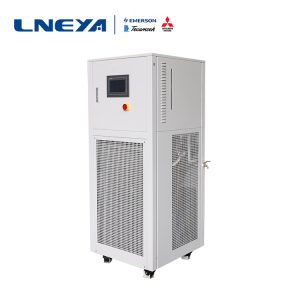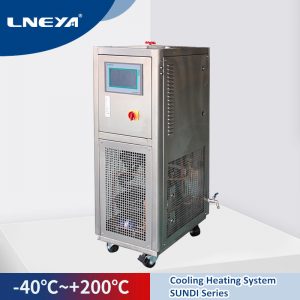Introduction Of Low Temperature Refrigeration Equipment Series-low Temp Process Chillers
Thermoacoustic refrigeration technology is a new refrigeration method with wide application prospects. It is one of the major advances in refrigeration and cryogenic technology in the past 30 years. Thermoacoustic engine uses thermoacoustic effect to convert thermal energy into acoustic energy, which can be used to drive thermoacoustic low temp process chillers. The combination of the two is called thermoacoustic driven refrigeration system. In thermoacoustic driven refrigeration system, when the temperature gradient of engine regenerator reaches its critical value, sound waves will be excited.
Acoustic wave makes gas micro-clusters undergo a certain thermodynamic cycle in engine regenerator: compression-heating-expansion-cooling. In this way, the conversion of heat energy to sound energy is realized without moving parts. When the sound wave passes through the regenerator of the refrigerator, a temperature gradient is generated on the regenerator of the refrigerator, and the heat is pumped from the low temperature end to the high temperature end. Acoustic wave makes gas micro-clusters undergo a certain thermodynamic cycle in the regenerator of refrigerators: compression-cooling-expansion-heating. In this way, the pump heat is realized without moving parts.
Compared with the traditional refrigeration technology, thermoacoustic refrigeration technology has many unique advantages, mainly reflected in:
(1)It has simple structure, high reliability and long service life. Especially thermoacoustic low temp process chillers can achieve no moving parts.
(2)Pollution-free refrigeration technology. Thermoacoustic refrigerators use inert gases such as nitrogen and helium as refrigerants, which can avoid the damage to the atmosphere caused by the use of Freon as refrigerants in traditional refrigerators.
(3)Take advantage of solar energy, gas energy and waste heat energy to provide heat source for thermoacoustic engine and output sound power. It drives a pulse tube refrigerator or a Stirling refrigerator, produces refrigeration effect and achieves thermoacoustic drive refrigerator without moving parts.
(4)By increasing the frequency of thermoacoustic low temp process chillers, the structure of the refrigerator can be miniaturized, which can be used for cooling electronic devices, semiconductor chips and other devices.
At present, thermoacoustic research has become the research focus and frontier in energy power, cryogenic technology, environmental protection engineering and other fields. The application of thermoacoustic refrigeration covers a wide range of temperature ranges from room temperature to liquid nitrogen temperature. It shows exciting application prospects in natural gas liquefaction, space exploration, infrared device cooling, electronic device cooling, room temperature refrigeration, thermoacoustic imaging and thermoacoustic communication.
Raccomandazioni correlate
-
What should I pay attention to when placing high and low temperature closed loop circulators?
899There are certain differences in the size and performance of high and low temperature fully enclosed circulators from different manufacturers. Users need to pay attention to the placement position when placing them after purchase. If the placement...
Visualizza i dettagli -
Temperature control thermostat equipped with microchannel reactor
1312microchannel reactor temperature control
Visualizza i dettagli -
Shutdown method in the case of high-precision high-low temperature circulator failure
1068The high-precision high-low temperature circulator is one of the equipments used in the pharmaceutical and chemical industry to support various reactors. If users encounter an abnormal power outage during use, they should pay attention to operatio...
Visualizza i dettagli -
Which equipment does a chemical plant use a heating circulator to heat?
1205In chemical plants, heating circulators are widely used to heat a variety of key equipment and devices to ensure that chemical reactions and processes are carried out under suitable temperature conditions. The following are some of the mai...
Visualizza i dettagli
 Refrigeratori industriali LNEYA Produttore Fornitore
Refrigeratori industriali LNEYA Produttore Fornitore












